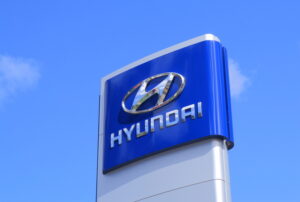By Eric Peters
It appears Hyundai will shortly be unveiling its first truck – not to be confused with a car or crossover that looks like a truck. The Santa Cruz – which has a four door cab and a small bed behind that – looks like a small truck. It’s actually a small crossover (the Hyundai Tucson) modified to look like a small truck. That’s not bad. It just means the Cruz – which has a front-drive/AWD drivetrain and a unibody surrounding that – isn’t a truck, properly speaking.
That’s why the announcement the other day by Hyundai’s CEO, José Muñoz, was so interesting. He talked about an-in-the-works truck that will be built using body-on-frame construction, strongly suggesting the vehicle in the works will be a truck because body-on-frame construction almost always means a front-engine/rear-drive layout, with 4WD either standard or available in the truck (and truck-based SUV) context.
Body-on-frame construction is preferable for heavy towing because the frame takes the load more so than the body (and it’s a lot harder to stretch a heavy I-beam-type frame rail than a wafer-thin body panel welded to a unibody) and also just harder to hurt generally, especially off-road – which matters to people who want a truck rather than something that looks like it might be. They also want 4WD, which usually means a two-speed transfer case and the leverage advantage of 4W Low range gearing. AWD has a traction advantage, chiefly – in that power isn’t just routed to all four wheels but in most instances can be routed in varying ratios up to 90 percent one way or the other as well as side to side, which does help with high-speed handling tenacity and control.
But the Santa Cruz is not a truck. It’s a modern-incarnation of the old VW Rabbit truck; the latter was a Rabbit with a bed, which made it look like a truck. It could even be used for some of the things people use trucks for, such as hauling garbage to the trash dump. It and others like it such as the Dodge Rampage became very popular.
Arguably, not so much because they could do some of the things a small pick-up could do but because they were small and cheap.They were about the same size as a compact sedan and so easy to park and easy to fit in the garage. They cost less than a compact sedanm too. But they were still trucks, with body-on-frame ruggedness and real 4WD rather than AWD. You could haul with them. You could plow with them. You could go off-road in them.
There used to be a half dozen such small pick-ups available in this country and they all stickered for less than $20,000 to start. Now there are none of them – at least not in the United States. Here, all that’s available are “full-size” trucks like the Ford F-150 and Chevy Silverado 1500 and Ram 1500 that are as long as and taller and wider than the 2500s of twenty years ago – and “mid-sized” trucks such as the current Ford Ranger, Chevy Colorado and Nissan Frontier that are taller and longer than the full-size trucks of 20 years ago.
Also well over $30k to start, each of them. The base price of the Santa Cruze is a couple grand less than that, which is no small thing and almost certainly accounts for some of the sales success of the thing. It’s fun, useful and affordable. The things the compact-sized trucks you used to be able to buy also touted – before it was all taken away. The compact-size trucks all became “mid-sized” ( full-sized, by the standards of the late ’90s and early 2000s) and both too big and too expensive, evidence in support of this claim being the fact that the current Ranger and Frontier and Colorado do not sell nearly as well as their small, half-the-price ancestors.
That’s the fly in the soup as far as Hyundai’s first truck.
It will be mid-sized and so the same size as the current Ranger, Frontier, Colorado and the others. This is probably a mistake as well as a missed opportunity. It’s a mistake, arguably, to try to horn in on a market segment that is already pretty much owned by the established players, who have the reputation among truck people that Hyundai does not because – after all- Hyundai doesn’t sell them yet. Plus, that market is probably already saturated – with brands – chasing too few buyers because these rigs are all well into the $30k-plus range to start and by the time you add 4WD and a couple of options, you’re sailing toward $40k.
That sum used to buy a basic full-sized truck with 4WD.
But the compact-sized truck segment is wide open. There’s the Ford Maverick – but it’s not really a truck, either – though it does look like one. (It’s a Ford Escape with a truck-looking body and bed). It’s also no longer cheap. When Ford initially said it would sell the Maverick for $19,995 to start, buyers lined up to put down a deposit. Then Ford welshed on the deal and now the Maverick’s base price is almost as high as the base price of a mid-sized truck such as the Ranger or the Frontier – so why not just get the larger one that’s also a truck?
What if Hyundai were to scale things down a little and offer a compact-sized truck that actually is one? With body-on-frame (rather than unibody) construction and an engine mounted front-to-rear that drives the rear wheels, unless the 4WD’s been engaged? Imagine that with a six foot bed like all the compact trucks used to have, as opposed to the 4-5 foot beds the crossovers that look like trucks (Santa Cruz and Maverick) have and real 4WD and a frame you can pull trailers with and stumps out of the ground. Imagine it in a basic configuration – no turbo-hybridized engine and how about just AC, power windows and locks. Hyundai could surely offer a small truck like that at or near just-under-$20k price point that caused buyers to line up around the block to put down a deposit on a $19k Maverick.
Toyota sells a basic little truck (the Hilux Champ)in export markets for about $13k to start.
Would a truck like that sell in this market? There’s no way to know without someone trying. We do know Ford got a lot of people excited about the Maverick before they got disappointed. Maybe Hyundai will do something different.
No, more like the same.
Does anyone remember the Excel? It was – back in the ’80s – just about the cheapest new car you could buy, which resulted in a lot of them being sold and – more to the point – resulted in Hyundai becoming the new Honda. Hyundai (and its Kia adjunct) are today very successful companies lacking one thing that sells very successfully.
Now if they would only offer the one kind that no one else is even trying to sell right now. Hyundai might become the new Toyota.







